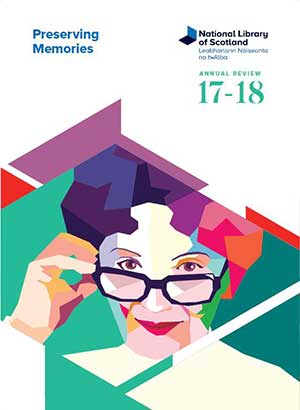
National Librarian's report
It's been a good year. Our exhibitions, tours, events and workshops reached almost 140,000 people, and we had yet another record number of visits to our website — more than 5 million. To ensure we continue to meet the growing demand for our collections, we intensified our digitisation activities and a further 129,000 books, maps and pamphlets were completed over the past year.
Our collections go back at least 1,000 years, placing us in prime position to provide deeper insight into anniversaries of importance. Through exhibitions, displays and events, we marked the 70th anniversary of Indian independence, the 500th anniversary of the Reformation, and the centenary of Shackleton's Endurance expedition. We also led the national celebration of the centenary of Muriel Spark's birth.
Our George IV Bridge Building is a stone's throw from where J K Rowling first penned 'Harry Potter and the Philosopher's Stone' in 1997, and on the 20th anniversary of its publication, we invited people to view a rare first edition with personal annotations by the author. We had more than 1,000 visitors that afternoon, and it was the first time live owls visited our Library.
Our new facility in Glasgow, which houses the Moving Image Archive, celebrated its first full year at Kelvin Hall and continues to generate lots of excitement. Refurbishment work on our Causewayside Building in Edinburgh is complete. After five long years, we now have a facility capable of housing a large part of our national collections into the future — accommodating physical collections on shelves and digital collections in our data centre.
As part of our commitment to extend our reach beyond Edinburgh and Glasgow, we have been on the road. We took the fascinating display 'Lifting the Lid' – on the development of the Scots diet over the past 400 years — to various locations, and our Moving Image Archive took a selection of films to festivals.
These are just some of the highlights and there is much to celebrate. But we must continue our efforts to reach new audiences. This year's programme includes an exhibition exploring Scotland after the First World War, and a display relating to Frederick Douglass, the prominent American abolitionist and orator. These will be complemented by cultural events, education, outreach and digital activity.
Everything we do is underpinned by our mission to make a significant and lasting contribution to global knowledge and the memory of the world. We have major plans in place — and continue on our quest to have our full catalogue online and a third of our collection in digital format by 2025. We are indebted to our volunteers, students and staff who all contribute to the success of the Library and in return, we do everything we can to help them on their career paths.
We cannot do this work without the generosity of our supporters. The continued advocacy and support from the Scottish Government allows us to preserve the memory of the nation. Support from our Patrons, Benefactors and Donors helps us to do so much more as we strive to be one of the leading national libraries in Europe.
Dr John Scally
National Librarian
Safeguarding collections
As guardian of the published and recorded memory of Scotland, we will continue to collect, preserve and make available a range of materials that capture Scotland's memory and contribute to world knowledge.
Acquisitions
The MacKinnon collection: 100 years of Scottish photography
Together with the National Galleries of Scotland, we acquired an exceptional collection of historic photographs that captures a century of life in Scotland. Thanks to the support of the Scottish Government, the Heritage Lottery Fund and the Art Fund, we will collaborate to make available to the public more than 14,000 images — dating from the earliest days of photography — 1840s — through to the 20th-century.
The collection covers a wide range of subjects — including family portraits, working life, street scenes, sporting pursuits, shops, trams, tenements, mountains and monuments. The photographs provide a visual record of how Scotland has changed physically, socially and economically since the 1840s. Originally put together by collector Murray MacKinnon, it is thought to be one of the last great collections of Scottish photography still in private hands.
W S Graham to Ruth Hilton around 1956-1985
Presented to the Library alongside poetry manuscripts and typescripts, artwork, related correspondence and published items, Graham's letters to Ruth Hilton are believed to be among the best the poet ever wrote.
Graham and his wife Nessie were very close to Ruth, particularly after Ruth separated from painter Roger Hilton — a close if sometimes antagonistic friend of Graham's.
This acquisition adds further colour to this most visual of literary archives, in the poet's centenary year.
'What Led to the Discovery of the Source of the Nile', 1864 by John Hamming Speke
An exceptionally rare find given it was never intended to be read by the public — a tale of a bitter feud between two of the greatest explorers of the Victorian age.
Speke was the first European to reach the shores of a great lake in Africa, which he named after Queen Victoria, and rightly identified as the source of the White Nile. When he originally wrote this book, it included a 'Tail', which includes details of his dispute with Sir Richard Burton, who contested Speke's claim as discoverer of the source of the Nile.
Speke's family and publishers — Blackwood — convinced him to omit the 'Tail' from the final publication, but Blackwood included it in a special edition of 12 copies for his family. There are only five known surviving copies in the world not held in private hands.
The Library also houses the William Blackwood and Sons archive, which contains a letter from Blackwood to Speke regarding the secret edition. It urges Speke 'to be very cautious, and not let any of these copies be sent about beyond your family circle'.
Edinburgh Festival Fringe programmes digitised
Upon receiving a large donation of ephemera from an Edinburgh resident, the Edinburgh Festival Fringe Society approached us to house the material. We took the opportunity to fill significant gaps in our collection of Fringe programmes, and the Fringe Society kindly donated surplus programmes from the 1970s.
With a view to digitising all the programmes in our collection in one quick project, a total of 58 individual programmes were digitised earlier this year — these date from the earliest programme the Library has, as published by the Fringe Society in 1960, until the then latest programme for 2017.
We are working with the Fringe Society to make the collection available online.
Conservation
The National Library preserves the memory of the nation with collections that span centuries. Out team of highly-skilled conservators are instrumental in helping us prevent further damage to centuries-old items, or conserve the items in keeping with their original aesthetic.
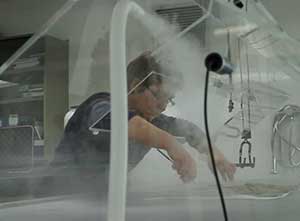
working on the 'chimney map'.
'Chimney map' released to the world
It arrived as a filthy, crumpled ball of linen some 10 years ago when it was donated to the Library after being found in a chimney in Aberdeenshire. Following a year of work led by one of our most experienced conservators, Claire Thomson, 'Nova Totius Terrarum Orbis Tabula' was released to the world.
The map was made around 1690 by Gerald Valck, a renowned Dutch mapmaker, and is extremely rare — only two other copies are known to exist.
Following a thorough clean, the map's degraded linen backing was removed and the fragments were reassembled and mounted onto a lightweight paper backing.
From March to May 2017, the map was on display in our George IV Bridge Building for all to admire. The map then went on loan to the National Trust for Scotland at Castle Fraser in Aberdeenshire, its possible origin. The map was discovered during the renovation of a property which was once part of the Castle Fraser estate.
Donations help repair fragile music collections
In the past year, we received donations which enabled our conservators to repair fragile collections or to put preventive conservation measures in place.
We identified 20 volumes of music manuscripts in need of major work. The manuscripts come from various collections and include bagpipe marches, musical farces, operatic arias and Christmas carols — capturing Scotland's rich history of musical performance, composition and dissemination. Thanks to a Library supporter and music enthusiast's generous donation, work on the manuscripts has begun, ensuring their preservation for years to come.
Improving Access
We are constantly working to make it easier to access out collections. By 2025 — the centenary of the Library's foundation — we will have completed a full online listing of our holdings and have a third in digital format.
The Library supports research, learning and business through our services, many of which are now delivered online and use digital technologies to allow greater access.
Digitisation
Our digitised resources are proving very popular. Last year, we digitised the manuscript journals written by Henrietta Liston — whose husband was diplomat Robert Liston — in North America between 1796–1801, with the aim of introducing her writing and experiences to a wider readership and supporting scholarly work and research. The digitised journals were displayed as an interactive map application on our website, allowing users to trace the couple's extensive travels. This year, the web resource resulted in two short films and an international academic collaboration, and Liston's travel writing has provided inspiration for creative writing and community groups throughout Scotland.
Another significant digitisation project involved past Scottish exam papers from as early as 1888. Not only have they informed educational research and been of great public interest, they have also inspired creative works by composers, musicians, dancers, and artists throughout Scotland through a creative bursary sponsored by the Library. The exam papers are now all available on our website.
Digitisation of maps continues, and we now have more than 200,000 high-resolution maps available online. These are used for many purposes, from the mining of geographical data for land conveyancing forms, to the study of how Scottish towns and cities have changed over time. The ongoing digitisation of the British First World War trench maps from 1915–18 allow the location of Allied trenches in France and Belgium to be overlaid on modern satellite and map layers. These have generated huge interest internationally.
Intake and cataloguing
We are working to make our 'hidden' — uncatalogued — collections available for users. This year, we catalogued 48,318 items, reducing the total estimated hidden collections by 4.45%.
Collections now in our catalogue include the Gourdie collection of books on handwriting and calligraphy, and papers from novelist Dorothy Dunnett's archive. We also completed the cataloguing of the Castle Fraser collection.
Right now, we estimate there are a further 1.2 million items to be catalogued — approximately 4.5% of our total print and analogue collections. A major retrospective music cataloguing project will begin this year, which will greatly reduce the number of hidden collections.
As well as digitising 'physical' items, we collect 'born digital' items, which helps us towards achieving our target of having one third of our collections in digital format by 2025. In the last year, we received 148,249 eBooks and 761,751 eJournal articles through Non Print Legal Deposit.
Data — increasing storage and speed
We installed a new hybrid storage unit which provides a third of a petabyte of data storage (the equivalent of six million four-drawer filing cabinets filled with text), along with 30 terabytes of flash storage. The flash storage means visitors to our website can retrieve data even faster, and helps accelerate our digitisation work. The new storage system is more energy-efficient than the old decommissioned system, which has helped decrease our carbon footprint.
We also upgraded our network within our data centres to ensure faster access to the new storage. Our Moving Image Archive and mass digitisation studios will greatly benefit from the higher speed networks, as will our online users as they access our digital collections.
Promoting research
We encourage and promote research as a defining characteristic of the Library. This includes research collaborations across the humanities, sciences and business, and supporting research communities.
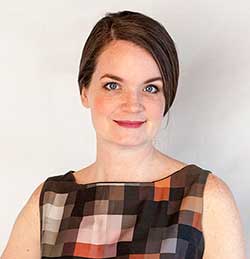
from the University of Glasgow.
Research collaboration with University of Glasgow
As part of our collaboration with CREATe — the Research Councils UK (RCUK) Centre for Copyright and New Business Models in the Creative Economy — Andrea Wallace completed her time with the Library as PhD partner from the University of Glasgow.
Working with our intellectual property specialist, Andrea researched the topic of 'Surrogate intellectual property rights in the cultural sector'.
Andrea looked into digitisation and the new rights that may arise in digital surrogates — reproductions —, as well as how to enable access so the public might reuse the valuable collections of the National Library and other institutions in the libraries, archives and museums sector to generate new knowledge.
Andrea said: "Having insight into the inner workings of a national institution engaging directly on these issues, and the challenges that arise when making collections available for public reuse, has been key to informing the research process."
Andrea will soon submit her PhD and has just completed her first year as a lecturer at the University of Exeter.
Unlocking our sound heritage
We have joined a UK sound preservation network that aims to save almost half a million rare recordings at risk of being lost forever. Led by the British Library and funded by the Heritage Lottery Fund, the network has 10 preservation centres, one of which will be managed by us at Kelvin Hall.
We will work with organisations throughout the country that have sound recordings in their collections. Examples include stories of the working lives of people across Scotland, interviews with prominent literary figures such as Edwin Morgan and Edwin Muir, and traditional Scots music and songs.
Scientific analysis of Scottish medieval chartularies
This research was part of a collaborative project with the Bodleian Library, University College London and Durham University to investigate the materials and techniques used to create these important medieval manuscripts, and put them into context with manuscripts from elsewhere.
Raman spectroscopy for pigment identification and hyperspectral imaging to create digital images provided information about how the manuscripts were written. The results have fed into a separate collaborative project with the University of Glasgow, exploring the chartularies from a curatorial perspective.
Supporting Learning
We ensure our collections and services make an important contribution to the education, learning and advancement of our citizens and the success of our nation.
Circadius project with youth development group
We worked in partnership with Muirhouse Youth Development Group to help deliver a project for young people aged 14–19 years, focusing on the history and development of travelling circuses in Scotland, and specifically on the connections to the communities of Muirhouse and Pilton in Edinburgh. The project was funded by the Heritage Lottery Fund (Young Roots).
The group visited the Library to meet curators and view material from the collections, including posters and playbills for circus performances in Scotland from the late 19th-century to the present day, as well as books on circus history.
The group was particularly interested in 'Birth of a Clown' by artist Sam Taylor-Johnson. The International Circus Clowns' Club keeps a record of its member clowns' make-up on egg shells so make-up can be copyrighted, and Taylor-Johnson's book is a photographic record of the egg shells. The group was so inspired by this book that they bought their own copy after the second visit, and used it as a key focus for the project.
The project also involved intergenerational sessions, where the young people interviewed older community members about their memories of travelling circuses coming to Muirhouse. They also learned circus skills such as juggling, uni-cycling, and walking on stilts, which they performed in May 2017 at North Edinburgh Arts Centre, alongside an exhibition showcasing their research.
As a result of our involvement in this project, we uncovered a wealth of material relating to circus history, which we featured in a display in autumn 2017.
Enduring Eye educational workshops
We devised a series of educational workshops for primary school pupils aged 7-11 years, based on the 'Enduring Eye' exhibition. The workshops focused on explorer Ernest Shackleton's expedition to cross Antarctica from 1914-17.
The pupils were given a tour of the exhibition, where they learned the story of what happened to Shackleton and his crew as they battled for survival against the elements.
Pupils responded to the exhibition by creating their own survival stories using drama, photography and creative writing.
From volunteer to conservator
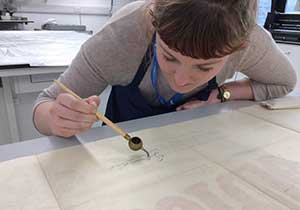
Helena Robson.
Our conservation volunteer programme, which began in 2014, is paying dividends for those who want a career in conservation and preservation. Our volunteers are most often students who are interested in careers working with library collections. They sometimes even return as conservation interns and leave with the skills and experience required to gain employment.
It's our aim to give conservation interns the best possible experience: the autonomy to make recommendations on treatment, supervise volunteers, and other relevant tasks for their portfolio to help make them more employable.
Helena Robson volunteered with us in 2015, which fuelled her interest in conservation as a career. Helena came back to us for a conservation placement this year as part of her 'Skills for the Future 'traineeship on collections digitisation.
She helped survey and condition-check a collection of deposited maps, assisted with the preparation, washing, pressing and repair of several outsized film posters from the 1950s and 1960s, and rehoused some newspaper clippings of the Miners' Strike 1984–85 and other topics from a collection put together by a former miner from East Lothian.
Keen to progress in the field of conservation, Helena is now undertaking a course in Furniture Craft at Edinburgh College.
Helping people gain employment
Rare Books intern now with Royal Collection
We received the great news this year that our Rare Books intern, Rachel Scott, who was with us in the summer of 2016, has been successful in getting a job with the Royal Collection Trust. She now works as Collections Information Assistant (Books and Manuscripts) at the Royal Library at Windsor.
Rachel's paid internship was made possible by the Librarian's Innovation Fund.
Rachel said: "I greatly enjoyed my time at the Library. It was an amazing experience and I felt that I learned a lot. I got to work alongside some very interesting and kind people who were willing to give up some of their time to supervise me and show me what they do. I felt the internship really confirmed to me that rare book librarianship was the career I wished to pursue and it gave me confidence to go forward in my studies and seek employment in this area."
Gaelic Digital Assistant's springboard to success
We hosted Sandra Corbett as Gaelic Digital Assistant, a pilot post funded by Bòrd na Gàidhlig and the Ruth Ratcliff Trust Fund. Sandra's focus was on developing our digital and online content, raising the profile of our Gaelic collections, and engaging Gaelic-speaking audiences. She worked with colleagues on a range of tasks, particularly on the digitisation of 'An Comunn' publications, and on a learning resource about the Iolaire tragedy.
A core principle of the pilot was that it should test the theory that a combination of Gaelic fluency and digital skills would enhance the employability of a young person in the current labour market. We were very pleased, therefore, that Sandra progressed quickly to a permanent job with MG Alba.
Special Collections intern now an archivist
Jennifer Roach completed an internship with us in archives, records management and rare book librarianship. The month-long internship — made possible by the Cross Trust — allowed Jennifer to gain experience in librarianship while completing her MSc in Information Management and Preservation at the University of Glasgow.
Jennifer carried out work in the Special Collections Reading Room, worked with material from the John Murray Archive, the Advocates Collection and the John Buchan Collection, learned how to create a hierarchical structure to catalogue material, edited a series listing relating to the Crawford Collection, audited pamphlets from the 17th and 18th centuries, and gained insight into the work of the digital department.
Jennifer said: "My internship at the National Library of Scotland provided me with the best start to my career I could have asked for. The variety of the internship has provided me with practical experience of fulfilling challenges which I now undertake on a regular basis in my current role. From auditing collections to editing and structuring series lists, I have a knowledge and understanding of how to approach these challenges to a high standard which has been invaluable to me."
Jennifer is now working as an Assistant Archivist at Ayrshire Archives.
Residencies
Animator in residence
Louise Wilde took up a post as the Library's first-ever Animator in Residence, based at the Moving Image Archive in Kelvin Hall. She spent the spring of 2018 holding workshops for local schoolchildren and college students, designing and creating an animation space for members of the public, and developing work in response to the Library's vast collections — including the work of notable Scottish animators and filmmakers such as Norman McLaren and Margaret Tait.
Louise said: "I'd been exploring early animation methods and creating hand-printed animated sequences at Edinburgh Printmakers, including using traditional printmaking methods such as etching. So when I saw the ad for the position, it seemed perfect, especially since I'd also been running workshops on early animation techniques."
Although her post has ended, Louise continues to respond creatively to content from the Moving Image Archive and to run workshops at the Library.
Sports writer in residence
We hosted our first-ever Sports Writer in Residence during 2017–18. Hugh Dan MacLennan, 'Mr Shinty' — a seasoned sports commentator — took the hot seat to raise the profile of our incredibly rich and extensive sports collections in magazine articles, and also on radio and television broadcasts.
A fluent Gaelic speaker, he also contributed to activities at the Mòd and with other Gaelic audience development, typically writing his articles in dual language.
Hugh put us in touch with all kinds of collectors and enthusiasts. We have since acquired a huge amount of collections content via donation, and expect to benefit from his connections for some time to come. His post also brought the Library into further contact with Sports Heritage Scotland, who use sport heritage as a resource with Alzheimer's groups and with people experiencing social isolation.
Inspiring engagement
We design and deliver public engagement programmes that educate, entertain and inspire the communities of Scotland.
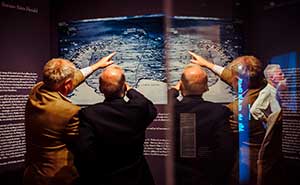
exhibition.
As the keeper of collection items dating back 1,000 years, anniversaries of significant events and people often guide our programme of exhibitions and displays, as this past year demonstrates.
Enduring Eye: the Antarctic legacy of Sir Ernest Shackleton and Frank Hurley
16 June — 12 November 2017
In an exciting collaboration with the Royal Geographical Society, we brought one of the greatest survival stories of all time — the Imperial Trans-Antarctic Expedition from 1914-17 led by Shackleton — to the Library on its centenary. The exhibition was enjoyed by 66,949 visitors.
More than 90 images, taken by official expedition photographer Frank Hurley and saved by him under the most extreme circumstances, formed the heart of the exhibition. It was complemented by items from the Library's polar collection, exploring the local heroes involved — particularly Sir James Mann Wordie whose archive and book collection we hold — as well as other Scottish links and the expedition's legacy.
Images of India
6 July — 20 August 2017
To mark the 70th anniversary of Indian independence from Britain, this display captured the visual world of pre-independence India as it was seen through the eyes of various religious faiths, artists and photographers.
Many Scots were part of the British Empire's administration in India. This was reflected in the display which included works produced by Indians brought back by Scots returning from service, as well as some of the early published illustrations produced by Scots who lived there.
The International Style of Muriel Spark
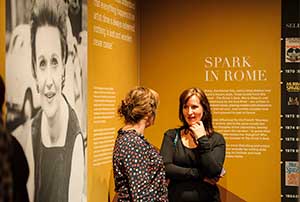
exhibition.
8 December 2017 — 13 May 2018
A pivotal event in the Muriel Spark 100 calendar — the year-long programme celebrating the centenary of one of Scotland's most important authors — this exhibition thrilled audiences with a rich variety of artefacts telling the life story of the author.
Fortunately for us as holders of the Muriel Spark personal archive, she threw very little away, and more than 42,000 visitors got up close to telegrams and letters from other contemporary literary greats, as well as notes from prominent 20th-century figures such as Elizabeth Taylor and Jacqueline Kennedy Onassis.
The Reformation
19 October 2017 — 14 January 2018
In October 1517, Martin Luther nailed a poster to a church door in Wittenberg, Germany, questioning some of the practices of the Catholic Church. His '95 theses', as the document became known, would go on to split the Christian world and have ramifications that continue to the present day.
Only a few copies of the very first printing of the 95 theses survived. One of those copies was on display at the Library alongside other original key texts of the Reformation, including an extremely rare copy of the papal bull which ultimately severed Luther's ties with the Catholic Church.
Robert Burns pop-up day
25 January 2018
On Burns Night, a letter from Burns that had not been seen by the public for more than 100 years went on display.
The letter was written to his former school-friend William Niven in 1786, just weeks after the publication of his first work: 'Poems, Chiefly in the Scottish Dialect', which was to make his name.
Harry Potter pop-up day
26 June 2017
We marked the 20th anniversary of the landmark publication of the first Harry Potter book — 'Harry Potter and the Philosopher's Stone' — by displaying a rare first edition filled with personal notes and drawings by J K Rowling.
In what turned out to be the busiest day at George IV Bridge since the visit of the Dead Sea Scrolls in 1966, more than 1,000 Potter fans and other muggles queued around the block for a rare sight of 'the special copy'.
Rowling's own handwritten comment on the title page — that the book "changed my life forever" — was echoed by many of the series' fans as it was their own introduction to storytelling and reading.
Also on display were special illustrated editions, signed first editions, and a sample of the many foreign language translations of this international phenomenon. Three live owls were also on display to captivate attendees, many of whom were in costume, while they waited to see the display.
Reaching out
We will continue to develop the National Library as an exciting and memorable destination for both onsite and online visitors, and explore opportunities to establish our physical presence throughout Scotland.
400 years of the Scottish diet
The fascinating story of the development of the Scottish diet over the past 400 years was taken on the road as part of our commitment to extend our reach beyond Edinburgh and Glasgow.
Based on the 2015 exhibition, 'Lifting the Lid: 400 years of food and drink in Scotland', the touring display introduced people to the Library's resources by using images and descriptions of the material that we hold in our collections.
In its first year, 'Lifting the Lid' reached upwards of 50,000 visitors across five regions and 11 venues.
University of Aberdeen's Sir Duncan Rice Library 5 June — 20 August 2017
New Lanark World Heritage Site Visitor Centre 23 September — 12 November 2017
Renfrewshire Libraries 27 November 2017 — 30 January 2018
Stirling Libraries 5 February — 30 April 2018
Funding our work
Income 2017/18
Grant in Aid
£18,421,000
Charitable activities
£593,000
Donations and legacies
£581,000
Investments
£189,000
Other trading activities
£123,000
Spending 2017/18
Staff
£10,675,000
Building maintenance
£3,105,000
Depreciation
£2,726,000
Other running costs
£2,393,000
Property costs
£846,000
Collection purchases
£806,000
![]() Download the 2017-2018 Annual Review (PDF) (1.2 MB; 24 pages)
Download the 2017-2018 Annual Review (PDF) (1.2 MB; 24 pages)
